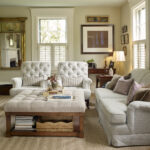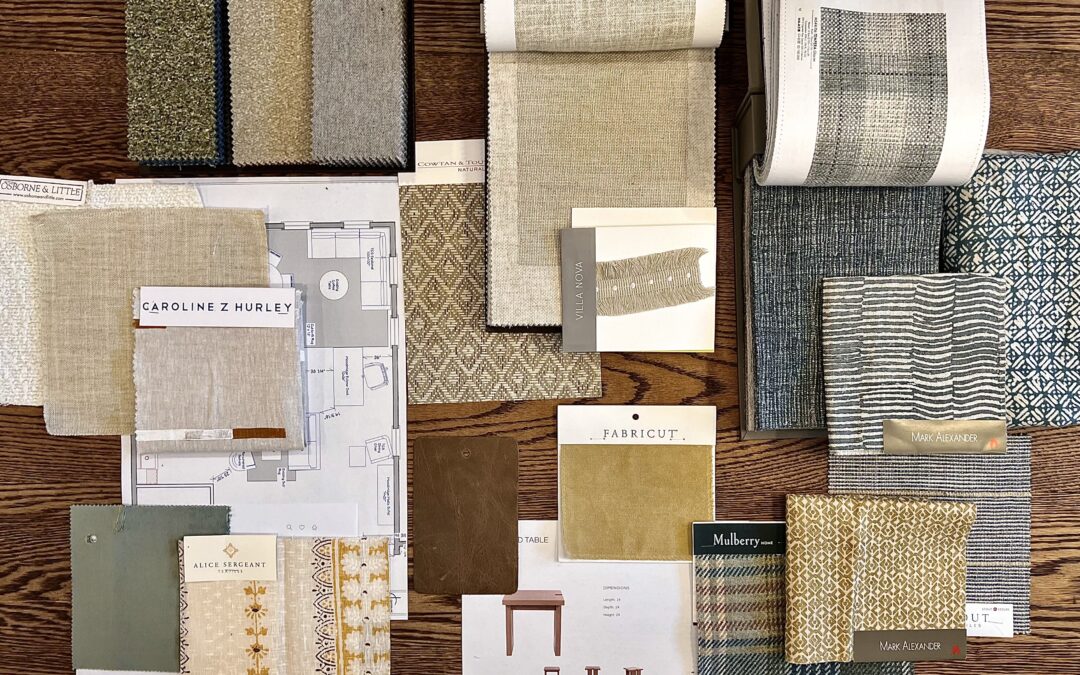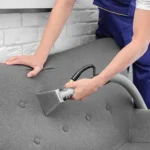In interior design, the choice of fabric is more than a mere detail; it’s a pivotal decision that shapes the ambiance and functionality of any space. At Centerline Design & Build, we understand that the right fabric can transform a room from ordinary to extraordinary. Whether it’s the plush comfort of a well-chosen sofa upholstery or the elegant drape of curtains, each fabric choice plays a crucial role in bringing a design vision to life.
Selecting the best fabrics for upholstery isn’t just about aesthetics; it’s about finding materials that stand the test of time while complementing the unique style of your Maine home. From the rugged elegance of wool to the sleek sophistication of synthetic blends, each fabric holds the potential to elevate your living spaces. As we delve into the world of interior design fabrics, let’s explore how these materials can enhance the beauty and comfort of your home.
Interior Design Fabrics: The Lay of the Land
The fabric you choose can define the character of your Maine home. Understanding the types of fabrics and their applications is crucial in creating beautiful and functional spaces.
Natural vs. Synthetic Fibers
Natural fibers, such as cotton, linen, and wool, bring organic beauty to any space. They are renowned for their comfort, breathability, and timeless appeal. Cotton and linen, with their natural cooling properties, are perfect for creating a relaxed, airy atmosphere in your home. Conversely, wool offers warmth and durability, making it ideal for cozy, high-traffic areas. However, natural fibers can be more susceptible to fading and require more care than their synthetic counterparts.
Synthetic fibers, like polyester and nylon, also offer practical benefits. They are typically more resistant to stains, fading, and wear, making them a smart choice for busy households. These fibers can mimic the look and feel of natural materials, providing versatility in design without compromising on durability.
The downside? They may lack the breathability and comfort of natural fibers, which is a consideration for seating applications.
Indoor vs. Outdoor Fabrics: Characteristics and Uses
 Indoor fabrics are designed to enhance the comfort and aesthetics of your living spaces. They range from luxurious velvets to elegant silks, offering a variety of textures and styles to suit any interior design theme.
Indoor fabrics are designed to enhance the comfort and aesthetics of your living spaces. They range from luxurious velvets to elegant silks, offering a variety of textures and styles to suit any interior design theme.
Outdoor fabrics, on the other hand, are built to withstand the elements. Made to resist moisture, mold, and sun damage, they are ideal for patio furniture and outdoor cushions. While they are incredibly durable, outdoor fabrics often have a stiffer hand and do not offer the same level of comfort, beauty, and elegance as indoor fabrics.
Stain Resistance and Health Considerations in Upholstery Fabrics
In today’s world, stain resistance is a highly sought-after feature in upholstery fabrics. Technologies like Krypton treatment enhance the fabric’s ability to repel spills without compromising its texture. However, some stain-resistant coatings have raised concerns about off-gassing and environmental impact.
Fabric Interior Design: Color and Texture Dynamics
In the world of interior design, the interplay of color and texture in fabrics can dramatically alter the mood and style of a space. At Centerline Design & Build, we understand the power of these elements in creating a home that resonates with the unique lifestyle and preferences of homeowners in Maine.
The Importance of Color Coordination for Interior Design
Color coordination is fundamental in fabric selection. It’s about creating a harmonious flow throughout your space. Whether you’re aiming for a serene, monochromatic scheme or a vibrant, eclectic mix, the right color coordination can bring balance and continuity to your home. It’s not just about matching shades; it’s about blending hues in a way that reflects your personal style and complements the natural lighting of your Maine home.
The Emotional Impact of Color Choices
Colors have the power to evoke emotions and set the tone of a room. Soft blues and greens can create a calming atmosphere for bedrooms or reading nooks. Bold reds or oranges, on the other hand, can add energy and warmth, perfect for social spaces like living rooms. Understanding the psychological effects of color can help you make choices that enhance your daily living experience.
Texture and Its Role in Aesthetics and Functionality
Texture in fabrics adds depth and interest to your interior design. A plush velvet sofa can invite relaxation, while a sleek leather chair might add a touch of sophistication. Beyond aesthetics, texture plays a practical role, too.
Durable, easy-to-clean textures are essential for high-traffic areas, while softer, more delicate fabrics might be reserved for less frequented spaces. In Maine, where the seasons change dramatically, texture can also be a tool to adapt your space to the climate, from cozy wools in winter to light linens in summer.
How to Assess the Best Upholstery Fabric: Understanding Quality
At Centerline Design & Build, we realize that knowledge of fabric characteristics is key to making informed decisions for your Maine home. This section will provide you with a quick overview of assessing upholstery fabric using various metrics.
Thread Count and Its Impact on Textiles and Upholstery Fabric
Thread count, often associated with luxury in bedding, is sometimes significant in upholstery fabrics. It refers to the number of threads woven into one square inch of fabric. A higher thread count typically denotes a finer weave and a smoother texture.
For upholstery, this translates to a fabric that’s not only visually appealing and feels good but also durable enough to withstand daily use. Whether it’s a cozy reading nook or a family-friendly living room, the right thread count can make all the difference!
The ‘Hand’ of Textiles: Fabric Selection for Comfort
The ‘hand’ of a fabric – its feel to the touch – is a subtle yet significant aspect of interior design. A fabric’s hand can set the mood of a room: a soft, velvety texture invites relaxation, while a more textured weave might add a sense of dynamism.
In Maine homes, where comfort and practicality go hand-in-hand, choosing a fabric with the right hand is essential. It’s about balancing tactile pleasure and functional durability, ensuring your furniture is beautiful and delightful.
The Wyzenbeek Number: A Key to Fabric Durability Rating
 When assessing the durability of upholstery fabrics, the Wyzenbeek number is a crucial metric. This rating measures how well a fabric can endure wear and tear before showing signs of distress. A higher Wyzenbeek number indicates a fabric that can gracefully handle the rigors of everyday life, making it an ideal choice for high-traffic areas in your home. From plush armchairs to elegant sofas, selecting a fabric with an appropriate Wyzenbeek rating ensures longevity and sustained beauty over decades, as opposed to years.
When assessing the durability of upholstery fabrics, the Wyzenbeek number is a crucial metric. This rating measures how well a fabric can endure wear and tear before showing signs of distress. A higher Wyzenbeek number indicates a fabric that can gracefully handle the rigors of everyday life, making it an ideal choice for high-traffic areas in your home. From plush armchairs to elegant sofas, selecting a fabric with an appropriate Wyzenbeek rating ensures longevity and sustained beauty over decades, as opposed to years.
This isn’t the end of the process for assessing the durability of fabrics, however. In the next section, we’ll go further into understanding and maximizing the longevity of fabrics.
Upholstery Fabric Durability Ratings and Maintenance
The longevity and maintenance of your upholstery are as important as its style. Understanding fabric durability and proper care ensures that your Maine home looks stunning and stands up to the test of time.
Understanding Martindale and Double Rub Fabric Ratings
Like Wyzenbeek numbers, Martindale and double rub ratings often measure the durability of upholstery fabric. These tests simulate the wear and tear of regular use, providing a reliable indicator of how well a fabric will hold up over time. The Martindale method involves a mechanical thumb rubbing against the fabric until it shows noticeable wear.
Similarly, the double rub test counts the number of back-and-forth motions a fabric can endure. Higher ratings in these tests mean the fabric is more suited for high-traffic areas, ensuring your investment remains pristine for years to come.
Maintenance Tips: Cleaning and Caring for Different Fabrics
Each fabric type demands specific care to maintain its appearance and longevity. Natural fibers like cotton and linen may require gentle cleaning methods to avoid shrinkage or damage. Synthetics, being more resilient, can often withstand more rigorous cleaning.
We recommend consulting care labels and considering professional cleaning for delicate or high-value items. Regular vacuuming, immediate attention to spills, and avoidance of direct sunlight can also prolong the life of your upholstery fabrics.
The Importance of Backing for Fabric Longevity
Backing is a critical yet often overlooked aspect of fabric durability. It involves adding a supportive layer to the fabric, enhancing its strength and resistance to stretching or tearing. This is particularly important for thinner fabrics, ensuring they hold up well when upholstered onto furniture. Backed fabrics are a wise choice for pieces that will see frequent use, combining aesthetic appeal with practical resilience.
Fabric Breathability Rating and Eco-Friendly Choices
In today’s world, the ethical and environmental impact of our choices is increasingly important. At Centerline Design & Build, we’re committed to guiding Maine homeowners through the maze of sustainable and eco-friendly fabric options, ensuring that style and responsibility go hand in hand.
The Breathability of Common Fabrics
Breathability is a key factor in fabric selection, especially in climates like Maine’s. Natural fibers like cotton and linen are highly breathable, making them ideal for comfortable living spaces. They allow air to circulate, ensuring a pleasant indoor environment throughout the year.
However, while less breathable, synthetic fabrics have made significant advances in technology to improve airflow and comfort. This makes synthetic fabrics significantly better options than they used to be for upholstering furniture.
Exploring a Sustainable and High-Tech Fabric Selection
Sustainability in fabrics is not just about the material itself but its lifecycle and impact. We explore options like recycled polyester and organic cotton, which offer a lower environmental footprint.
Additionally, advancements in fabric technology have led to the development of high-tech, eco-friendly materials that are durable, stylish, and kind to the planet. These innovative fabrics are a testament to the fact that luxury and sustainability can coexist beautifully in your Maine home.
The Origin of Fabrics: Ethical Considerations
The source of your fabrics matters. We prioritize ethically sourced fabrics, ensuring they are produced under fair labor conditions and with minimal environmental impact. This includes considering where and how the fabric is made, from harvesting raw materials to the final production process.
Choosing Your Fabrics
Selecting the perfect fabric is a crucial step in any interior design project. At Centerline Design & Build, we understand that each Maine home has its unique story and style, which is why we offer a personalized approach to fabric selection.
Factors Influencing Fabric Selection: Personal Taste, Space Layout, and Budget
 Your personal taste is the cornerstone of our fabric selection process. Whether you lean towards bold patterns or subtle textures, we ensure your fabric choice reflects your style. The layout of your space also plays a pivotal role.
Your personal taste is the cornerstone of our fabric selection process. Whether you lean towards bold patterns or subtle textures, we ensure your fabric choice reflects your style. The layout of your space also plays a pivotal role.
We consider factors like natural light, room size, and furniture placement to recommend fabrics that enhance your living environment. Budget considerations are equally important. We strive to find the best fabrics that align with your financial plan without compromising quality or aesthetics.
Centerline Design & Build’s Customized Fabric Selection Process
Our process is collaborative and thorough. We take the time to understand your vision, lifestyle, and the unique aspects of your Maine home. With our expertise and your input, we navigate the vast world of fabrics, ensuring that the final selection meets and exceeds your expectations. It’s not just about choosing a fabric; it’s about weaving your narrative into the very fabric of your home.
The Bottom Line
Choosing the best fabrics for upholstery and interior design is more than a decision—it expresses your unique style and comfort. At Centerline Design & Build, we encourage you to blend informed choices with creative flair, transforming your Maine home into a reflection of your personal taste and lifestyle.
Make Your Vision a Reality with Centerline Design & Build!
Ready to embark on a journey of transforming your space? Connect with us at Centerline Design & Build. Our expertise in custom furniture and textile selection is your gateway to a home that’s aesthetically pleasing and embodies your dreams and ideas. Let’s weave your story into the very fabric of your home!

